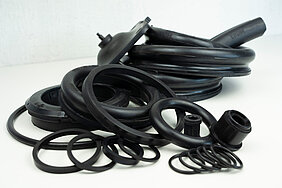Since 7 March 2022, elastomers and thermoplastic elastomers (TPE) also fall within the scope of the evaluation criteria document for plastics and other organic materials in contact with drinking water (KTW-BWGL) published by the German Environment Agenca UBA. This has been valid since March 2021 and previously already included plastics, organic coatings and lubricants.
Due to the transfer of elastomers and TPEs to the KTW-BWGL, a new positive list of starting substances is valid for these materials. Accordingly, some elastomer qualities now have to be re-tested for limit values of the peroxide cross-linking agents used. Other elastomer materials, however, are expected to be omitted due to the changes in the positive lists after the end of the transition period on 1 March 2025. End customers of elastomer components such as O-rings can continue to use "old" test reports according to the Elastomer Guideline until 01.03.2025 even within the scope of a certification. At the same time, these test reports may be a maximum of 10 years old. After March 2025, only test reports according to KTW-BWGL are valid for elastomers and TPE.
Product groups according to surface in contact with drinking water
After the transfer of elastomers and TPEs, the risk-based group of components or products is also carried out here according to the surface that comes into contact with drinking water in the assembled product. Pipes and hoses as well as equipment with a surface area of more than 10 % fall into group P1 and must therefore meet the highest requirements. Between 1 % and 10 %, the components are in group P2 and below 1 % in group P3. Depending on the grouping, a conversion factor is specified for the calculation of the results. These must withstand different limit values in each case.
With the 3rd amendment to the KTW-BWGL, a passage was added to the KTW-BWGL stating that wetted surface of components made of the same base polymers must be summed up. This amendment applies to all materials in the KTW-BWGL. This can result, for example, in the classification of several P3 components made of the same material in risk group P2. An exception to the rule is that ring seals or gap rings are never grouped into risk group P1, but can end up in group P2 at most, even after summation.
Requirements for testing according to DIN EN 16421
The requirements for testing in accordance with DIN EN 16421 provide only one limit value for plastics and coatings. This is independent of the area of application. For products or components according to Annex D (elastomers), there are three different limit values which must be complied with, depending on the area of application. The nomenclature ranges from M1 (highest requirements), e.g. for pipes or hoses, to M3 (lowest requirements) for small-surface components of equipment.
The TZW test centre is already accredited as a test centre for testing in accordance with KTW-BWGL and will be happy to provide further information.
Link to the services of the TZW test centre

![[Translate to English:] Prüfstelle-Produktprüfung_Teststand Test centre and product testing](/fileadmin/_processed_/0/9/csm_TZW-Karlsruhe_Pruefung_Geraete-Teststand_377188946c.jpg)
























